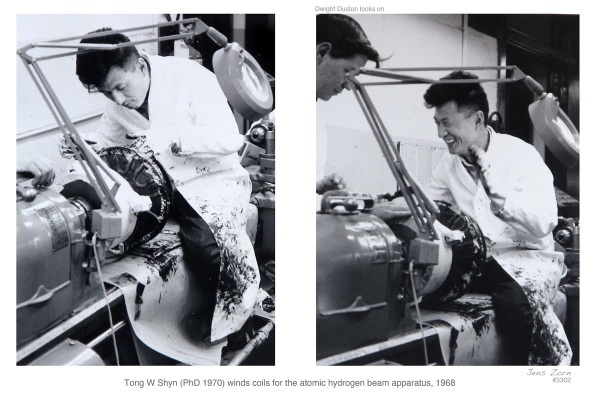Bill Williams did his PhD at Yale and was persuaded by Peter Franken, Dick Sands and Jens Zorn to join the Michigan physics department in 1965. Williams immediately started an ambitious program of experiments in atomic physics. This included a re-examination of the fine structure of atomic hydrogen to resolve issues that arose when Richard Robiscoe’s measurements of the Lamb shift (done at Chicago for his 1964 PhD thesis and then again in 1965 when he was a postdoc at Yale) gave results that differed significantly with the then-accepted value. Robiscoe then came to Michigan in 1966 to join Williams in a new hydrogen experiment; their apparatus is shown here:
The magnetic fields for these experiments, produced by water-cooled coils mounted externally to the vacuum system, had to be stable and well-controlled. homogeneous over the region traversed by the beam. Those fields were produced by water-cooled coils mounted on the outside of the vacuum system. The photograph below shows Tong Shyn, then a graduate student, straddling the bed of a lathe in the student shop as he winds the magnet’s coil. He is spattered by the heavy varnish used to keep the copper conductors in place.
[Ater finishing his dissertation with Williams, Shyn moved to the University of Michigan’s Space Physics Research Laboratory where he and his students did a long series of elegant experiments on electron-atom collisions in order to measure cross sections needed for modeling of the atmosphere.]
Robiscoe left Michigan in 1969 to accept a position at the University of Montana in Bozeman. Within a few years experiments of a different sort were yielding a more reliable value of the Lamb shift. But Williams did not lose interest in atomic hydrogen; in fact he and Robert Lewis began to see a way to test for the violation of parity in this simplest of atoms. We will tell that long and complicated story in a further installments.
